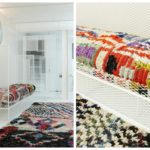The secret life of a Berber rug
We believe that each rug we sell is a work of art. Through the materials used, the colours employed and the motifs within, each tells a unique story of the environment, lifestyle and community that produced it. Taking just one rug in our collection as an example – a rug woven by Berber women in Morocco – Emily’s House London founder Katrien explains some of the factors which make Berber rugs so unique and special, from the mix of tradition and creative freedom that weaving allows, to the communal aspect of their creation.
The fabric of life
“All the carpets that we have are made by ‘tribal weaving’ – this means that they are made by women for domestic purposes, like blankets and bedding, in their everyday lives. There is a very traditional way of living where the woman looks after the children and the household, and she makes these rugs for use at home in her spare time.”
A sense of place
“If we look at this particular rug (above), it’s a Moroccan rug that comes from the Middle Atlas mountains – a very cold area that is very well-suited for raising sheep and the high quality wool that they use in weaving. The people living there are still very traditional and often still live a semi-nomadic life where they stay with their flock, moving to the high lands in the summer and coming back down to the low lands in winter. They use natural, undyed wool as much as possible in their rugs, as it is abundantly available for them.”
Women’s work
“Weaving is something the women do together. It’s a collective female activity. Men will never be weavers as they don’t take care of the household. There is always one woman who will initiate the rug, and be responsible for it. But she will need other women to help put up the loom or to stitch or weave certain motifs that she isn’t able to do.”
“At 90 many of the women are still active in weaving!”
A lifetime of weaving
“Making rugs is something that is deeply rooted in their everyday life – they don’t question it, they just do it. It’s something that they learn from their mother or grandmother, or from another lady in the local village. It is passed on from one generation to the next. You can become a weaver in your adult life but normally women start at around six years old. They may have a break when they have kids, but at 90 many of the women are still active in weaving! It’s something that runs through a whole lifetime.”
Tribal tradition
“It’s not about the individual, like in Western culture – in this culture the individual is subordinate to the group. A weaver will always create within the tradition of her tribe. So a certain tribe might always use specific motifs or a certain colour of wool, and women of the tribe will always use these as a way of identifying with their tribe. Again she is subordinate to the group – it’s not her individual style she wants to put forward. It’s more that she wants to say ‘I am part of this tribe, so I weave like this.’”
“Each woman invents the rug in her mind as she weaves it”
A creative act
“Because they weave these rugs in their free time, when all the other household tasks are done, it’s never a main occupation. The weaver doesn’t have to go to work and finish within a set time. This means that she has no commercial pressure on her – she can make the rug in the way she feels it has to look, not based on any specific colour, or fashion. Although tradition is paramount in these designs. there is also a lot of freedom in the weaving. There is no drawing to follow, meaning each woman invents the rug in her mind as she weaves it, with a lot of freedom to incorporate her own ideas and fantasies if she wants.”
This feature is an edited version of a speech given by Katrien at 19 Greek Street’s L’Apartment du Progress exhibition.




Leave a Reply
Want to join the discussion?Feel free to contribute!